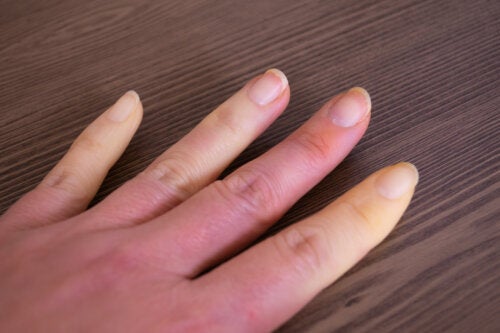What is Raynaud’s Syndrome?
Raynaud's syndrome is a vascular disease that can affect the nipple. During lactation, it should be treated to avoid weaning.

Raynaud’s syndrome is a vascular disease that produces a transient lack of oxygenation of the most distant tissues of the body. One of the areas that can be attacked by this phenomenon is the nipple, which causes severe pain during breastfeeding.
Unfortunately, this condition is the cause of many cases of early abandonment of breastfeeding, but there’s a treatment to control it. How does this disease manifest itself and how are its symptoms managed? We’ll tell you about it in the article below.
Raynaud’s syndrome
Raynaud’s syndrome is a disease in which a transient narrowing of small caliber blood vessels occurs. Specifically, it occurs in the small caliber arteries that irrigate the skin, which hinders the flow of blood to the more “distant” tissues of the body: The hands, feet, nose, or nipples.
This vascular spasm is manifested with changes in the coloration and temperature of the aforementioned structures and is usually more frequent in the female sex. In fact, it’s estimated that Raynaud’s syndrome of the nipple affects 20% of women of childbearing age.
This problem is due to the negative consequences that occur when breastfeeding a baby: Intense and stabbing pain, changes in color, ulcers, and cracks in the nipple
Raynaud’s syndrome is usually confused with an infection caused by the fungus Candida albicans because of the pain. However, a specialist will know how to establish the correct diagnosis with a clinical examination.

What causes Raynaud’s syndrome?
The exact cause of this disease is still unknown. However, some risk factors that predispose one to its occurrence are known:
- An exaggerated vascular response to cold (episodes are more frequent in winter).
- Emotional stress: When there’s stress, catecholamines are secreted, substances that predispose one to vascular spasm.
- Mechanical breastfeeding problems, such as poor nipple attachment or a short frenulum on the baby’s tongue. Both situations cause trauma to a sensitive area and can trigger the symptoms of the syndrome.
- Nipple infections.
- Smoking.
- Alcohol consumption.
You may also be interested in: How to Take Care of Your Breasts During Breastfeeding
What are the symptoms of Raynaud’s syndrome of the nipple?
The manifestations typical of this condition usually have a variable intensity and frequency, so they can appear during feeding or a few minutes after breastfeeding.
Below, we can describe the most significant discomforts:
- Nipple pain: Of great intensity and sudden onset in the nipple. Many women describe them as pins and needles which occur around feedings. They get worse with cold and improve when heat is applied to the affected area.
- Color change at the tip of the nipple: Because blood doesn’t reach the tip of the nipple properly, the nipple turns white after feeding. It then turns purple and then returns to pink.
- Cracks, sores, or blisters on the nipple.
When blood flow returns to normal, there’s a throbbing or tingling sensation over the nipple and the skin becomes reddened. These symptoms can affect both breasts, but not simultaneously.
The treatment of Raynaud’s syndrome
The treatment of Raynaud’s syndrome during lactation is aimed at relieving discomfort and preventing complications related to ischemia of the breast tissue. Therefore, it aims to reduce vasoconstriction and promote vasodilatation in the nipple area.
Among the measures recommended to treat it are the following:
- Avoid exposing the mother to cold, especially while breastfeeding.
- Choose clothing that keeps the affected area warm.
- Breastfeed in warm places.
- Apply heat to the nipple area before and after feedings. A good technique is to use a cotton sock, fill it with uncooked rice, knot it, and heat it in the microwave for a few seconds. Then, place it on the breast, warm the area, and immediately offer the baby a feeding.
- Correct bad breastfeeding positions that favor nipple trauma.
- Consume warm drinks before breastfeeding, but avoid coffee or other beverages containing caffeine or theine because of their vasoconstrictor effect.
- Perform relaxation activities to reduce stress. Similarly, if breastfeeding motivates this feeling, relax and calm any fear before offering the breast.
- Maintain an aerobic exercise routine and consume supplements of magnesium, calcium, vitamin B6, and evening primrose oil.
- Avoid smoking.
- Consider using oral analgesics to manage pain.
40% of breastfeeding mothers report a relief of symptoms after implementing these recommendations.
In case these persist, the specialist will indicate a pharmacological treatment with oral nifedipine, an antihypertensive drug quite effective and compatible with breastfeeding.

Avoid early weaning!
Although Raynaud’s syndrome of the nipple often causes discomfort and makes breastfeeding difficult, it shouldn’t be a cause for early weaning.
With the implementation of appropriate measures, the symptoms usually subside and allow the mother to breastfeed. That’s why it’s important to have the support of a lactation consultant and to ask for help from your family doctor whenever you need it. This way, you’ll be able to provide your baby with the most precious nourishment there is.

